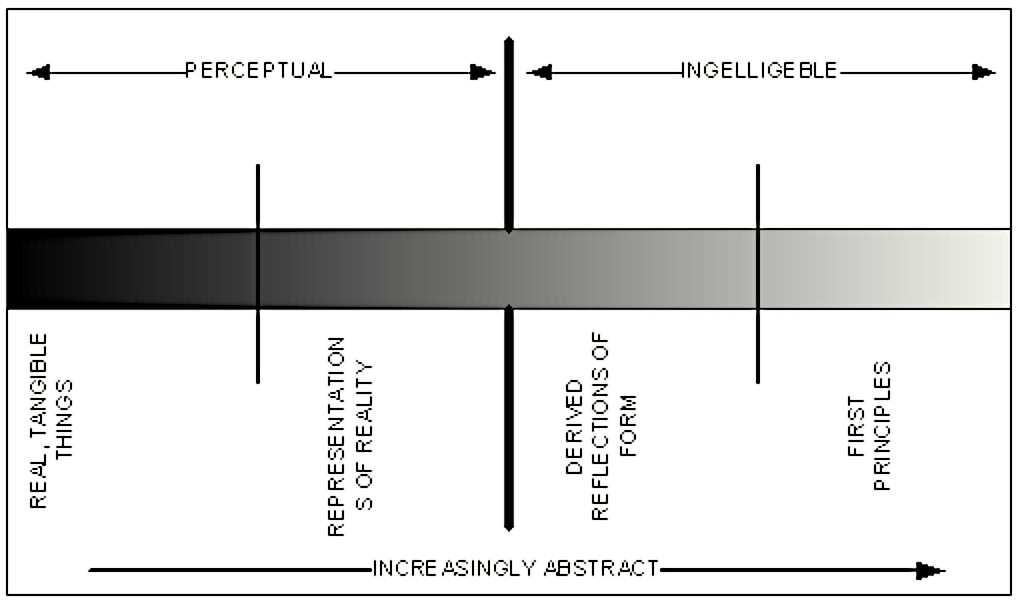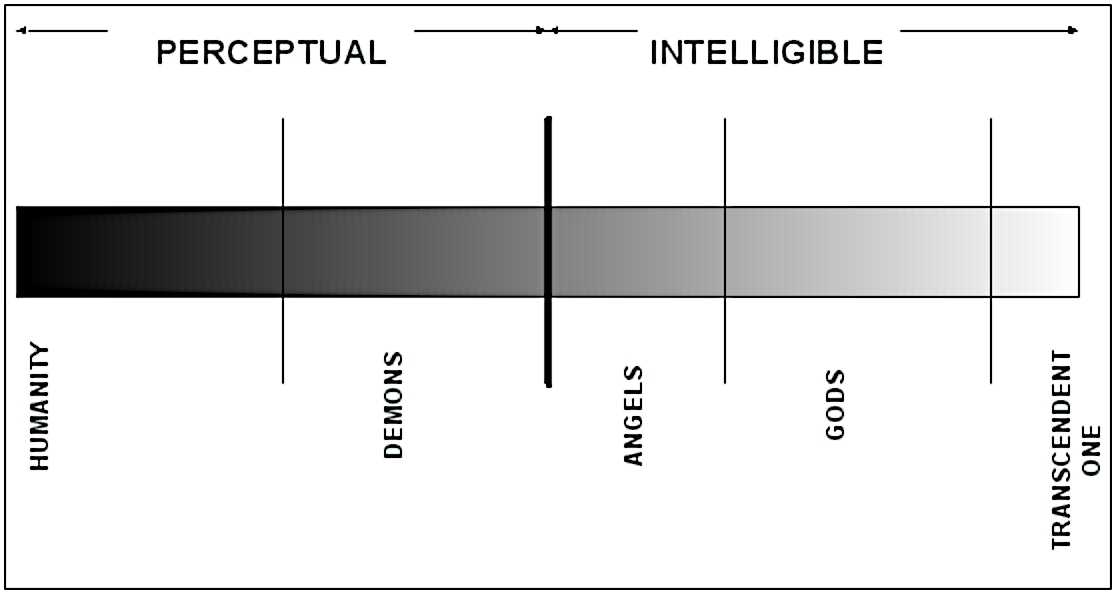Chapter 12
The Gnostic Connection
Humanism vs. Christianity
The Polarization of America
by Patrick Vosse

Living Water at Christianity Oasis
John 7:38 He that believeth on me, as the scripture hath said,
out of his belly shall flow rivers of living water.

Part Two
Know the Foe
Chapter 12 - The Gnostic Connection
One would be justified in asking why I would include a chapter on Gnosticism in a book about Humanism and Christianity. There is a connection between Humanism and Gnosticism that is not obvious at first but nevertheless exists. The connection is particularly surprising when one considers that Gnosticism is focused on the supernatural and Humanism is vehemently opposed to the supernatural. Humanist and Gnostics have a common foe, Christianity, and a common philosophical principle, Man can achieve "divinity" through knowledge.
If you want to get someone's attention, tell him or her you know a secret. We all love knowledge, particularly forbidden knowledge. Satan knew that in the Garden of Eden. Forbidden knowledge is the most tempting fruit. He did not tempt Eve with the fruit of any other tree because he knew the temptation of secret and forbidden knowledge would do the job. As we have seen, Satan has built into his religious system a large body of secret knowledge only available to those initiated into the "deep secrets of Satan" (Rev 2:24).
We are told in Genesis that Satan temped Eve to eat from the Tree of Knowledge of Good and Evil. What is knowledge of good and evil? We see in the Bible numerous instances of poetic phrasing to state a truth. The use of the phrase, "good and evil" is a mirism;[1] a literary tool by which totality is express by the first and last in a series or opposites. Jesus is the "Alpha and Omega," the beginning and the end (the first and last letters of the Greek alphabet), Rev 21:6, implying that he is everything in between. In Ps 139:2 we read: "You know when I sit and when I rise," implying that God knows everything he does. In the Bible, stating opposites often means inclusion of everything encompassed by those opposites. If we apply this interpretation to the Tree of Knowledge of Good and Evil, the implication is that this is a comprehensive knowledge of everything: a more complete knowledge than Adam and Eve had.
It was not just knowledge that enticed Eve to sin, it was the implication that the knowledge was secret, i.e. occult (hidden). Satan told Eve that God wanted to keep the knowledge a secret because if Man knew the complete knowledge, Man would become a god. The word used in Gen 3:5, for God is elohim and can refer to any divine entity such as the demons worshiped by the pagans.
Adam and Eve already had knowledge of God, as mentioned above. They communed with God daily. They knew "Good": a personal relationship with God, the presence of God, the love of God. Why would they want to throw all that away for the secret knowledge that would make them "like God"? Probably, they wanted independence from God. If they were to become "like God," they would not need God: And that was the real sin. By living without God, they frustrate the reason for their existence: to have a complete knowledge of God and fellowship with him and share a mutual love. Adam and Eve did not just walk away from God; they CHOSE to walk away from God. In one sense, Adam and Eve were the first Humanists.
The Roots of Gnosticism: Superstition, Animism, and Shamanism
Superstition is an incorrect belief about the relation between certain actions and other actions. The practitioner of superstition believes that the future, or the outcome of certain events, can be influenced by certain specified behaviors. "Good luck" and "bad luck," in fact the concept of "luck" in any form, are superstition. Superstition is not based on reason and is often an incorrect application of cause and effect or statistics. Many superstitions arise from fears, particularly of demons, spirits, or gods. Underlying superstitious behavior is a belief that there is a supernatural force or entity that can influence the outcome of our actions. Typically there is no logical evidence to support this belief but erroneous conclusions are made from observations. Superstition is ubiquitous; found in every culture and every educational and social status. Superstition is the basis for Satan's World Religion.
As mankind developed culturally, the ability to define and explain the supernatural developed as well. The ubiquitous but undefined supernatural force or forces of superstition were given names: spirits. Animism is the belief that personalized supernatural beings (souls or spirits) inhabit all objects and govern their existence. These spirits may be anonymous or may be given a personal name. They may be native to the supernatural world or, in some cultures; they may also be spirits of ancestors. In all cases they, as with basic superstition, must be appeased and petitioned for their favor. However, Animism goes one step further than superstition. Now that the supernatural force is known and its location identified, some structure can be developed in the communication process with the supernatural. The supernatural essence or soul may be an integral part of the plant, animal or object just as the human soul is an integral part of men. These are the attached souls.
In addition to the attached souls, unattached spirits can occupy the physical world. In many cultures, these spirits are free-roaming and usually malevolent, but they may attach themselves to plant, animals, or inanimate objects. The source of these spirits varies from culture to culture. The attached souls are usually a normal phenomenon just as our souls are a part of us. The unattached spirits may be attached souls that have been released and wander about. (Many animistic cultures believe the soul survives death.) Or they may be spirits that characteristically are not attached. In more advanced Animism, the souls of deceased humans are part of the unattached spirit world. The spirits associated with objects can be good or bad and simple rituals are used to appease the bad spirits and solicit favor from the good spirits; not unlike superstitious rituals; but with a personal touch.
Early cultures eventually developed more sophisticated methods of survival and better language skills that allowed for better communication. These led to less time devoted to securing food and shelter and a greater amount of time available for leisure. The increase in discretionary time and better communication allowed for the development of more sophisticated animistic rituals and more complex systems of explanations for the observed phenomena. But the demonic influence Satan introduced with Animism is brought to a higher level with Shamanism.
In animistic cultures, there usually arises an individual who appears to be more attuned to the supernatural or simply has a greater interest in it. When a society develops some leisure, these individuals are able to devote more time to the rites and rituals. Satan is always ready to capitalize on such opportunities. The demons that occupy the Animist's world can possess the Shaman and provide a direct link to the supernatural. When this happens, Satan's religion is raised to a new level. Modern psychology and psychiatry tend to dismiss possession as forms of mental disorders, such as multiple personality disorder. However, there are numerous biblical references and anecdotal examples to support the phenomenon. Here are some scriptural references concerning spirit (demonic) possession and associated demonic practices:
Contact with the spirit world
- The Lord said: "I will set my face against the person who turns to mediums and spiritists to prostitute himself by following them". Lev 20:6
- Dt 18:11 warns against mediums and spiritists.
- In 1 Sam 28:5-14, Saul goes to a woman who is a medium and she brought a spirit out of the ground for Saul to consult.
Foreseeing the future
- In Dt 18:20 God warns against any who prophesies in the name of other gods. (Also see Dt 18:11-14)
- In Gen 41:8, Pharaoh send for the magicians and wise men to interpret his dream.
- In Dan 2:1-11, Nebuchadnezzar sent for magicians, enchanters, sorcerers, and astrologers to interpret his dream.
Possession by spirits
- In Gen 6:1,2, spirits beget children with human women.
- In Mk 1:23-26, Jesus casts out an evil spirit from a man in the synagogue.
- In Matt 12:22,23, Jesus casts out a demon that possessed a deaf and blind man. The man could see and hear after the demon was cast out.
- In Matt 8:28-34, Jesus casts out demons from two men in Gaderenes. The demons were sent into a herd of pigs.
- In Matt 15:22-28, Jesus cast out a demon from the daughter of a Canaanite woman.
- In Matt 17:14-18, Jesus casts out a demon from a boy who suffered from seizures.
Affect the natural world
- In Ex 7:10-12; 7:20-22; and 8:6,7, the Egyptian wise men, sorcerers, and magicians, using their secret arts, were able to duplicate Aaron's miracles of changing a staff into a snake, turning water into blood, and summon up a plague of frogs.
- In Acts 8:9-11, the apostles confront Simon the sorcerer who was famous throughout Samaria for his magical abilities.
It is clear that animistic practices were commonplace, are confirmed in the Scriptures, and that they had a profound impact on the affairs of the Bible. There really is supernatural power available to men outside of God's realm. Men have access to Satan's demonic spirits; but that access has a high price. With the establishment of the possessed Shaman as part of the animistic culture, it became possible for demons to communicate with the community. The demon could impart knowledge to the Shaman and this would give him considerable power within the community. In typical shamanic possession, the Shaman enters into a trance that makes him/her more susceptible to receiving the demon. This preparatory stage can be rhythmic dancing, chanting, hypnotic drugs, or any combination of these that lowers resistance to the demonic influence. Once the Shaman is possessed, the demon has control and can manipulate the Shaman and the rituals involved. I have had the opportunity to witness this type of Shamanism in Indonesia on several occasions, particularly in Bali where there is a strong Hindu influence.
Satan is clever and patient. It is his strategy to win over the community. He wants the community to rely on the Shaman for good things or to prevent bad things. This is just an intermediate step in the development of religion. So, through the Shaman, the demon communicates the secret supernatural knowledge – and power.
Typically the Shaman is the tribal "witch doctor" who, through various rituals, chanting objects and herbs, affects healing of the sick and injured. The Shaman also is the expert on the demons themselves; knowing how to appease them and how to ask for favors. Through the demons he/she has special knowledge that other do not have. And, typically, the Shaman can interpret omens and foretell events. As a result, the Shaman holds a special place in society; doctor, priest and, often tribal leader.
But there is a dark side to Shamanism that exposes the demons' true nature. In many cultures, Shamans can cause spells, curses and generally bring evil to those in the tribe that bring the wrath of the Shaman upon them. Thus, while the Shaman is an object of respect and awe, he/she is also to be feared. A modern day example of Shamanism is Voodoo. The actual term for Voodoo is Vodun, an African word for "spirit." The practice of Voodoo in Africa goes back to at least 6,000 years and continues today in several non-African countries. The spread of Voodoo to other parts of the world was due to African slaves who brought their religion with them. The actual religion, Vodun, is practiced in Benin, Dominican Republic, Ghana, Haiti, Togo and various centers in the US - largely where Haitian refuges have settled. By some estimates, there are 60 million who practice Voodoo. As Shamanism developed and civilization advanced, Satan as prepared to bring his religion to more advanced stage: Paganism.
The Second Stage in the Development of Gnosticism: Paganism
Most have heard the term "Pagan" or "Paganism", but few know much about it. Paganism is as old as mankind and as new as laptop computers and cell phones. Paganism is a religion of nature. Pagans see the divine as immanent in the whole of life and the universe; in every tree, plant, animal and object, man and woman and in the dark side of life as much as in the light. Pagans live their lives attuned to the cycles of Nature, the seasons, life and death. If you think that pagan idolatry is just superstitious, rote observance of sophisticated Animism and Shamanism, think again. True it is all that – at one level. But it is much more. Let's go back to the Shaman in the primitive village. Recall that his practice included trances and demon possession and that through this communication with the satanic influences, he was given knowledge and powers that the rest of the community did not have. As the cultures developed the Shaman class developed into the priest class of paganism. The priest class developed more elaborate rituals and concepts of the supernatural world, a primitive theology. Their communication with the demon was also raised to a higher level as Satan responded to the opportunities of advanced civilization. So the gap between priest and commoner increased. The community's knowledge of the supernatural came only from what the priests told them and their traditions handed down from their Animistic past. This was the visible, public paganism. But there is another aspect to paganism that is hidden, powerful and, evil: the occult, the hidden knowledge Satan promised Eve.
Roots of the occult are found in Neolithic Shamanism but the full development is first observed in Egyptian idolatry. We are interested in the occult development mostly as it has affected Israel, Christianity, and modern society. In this sense, we will trace occult idolatry, beginning with Egypt, then Babylon, Persia, and finally Greco-Roman. First, let us define occult idolatry. In each of the idolatry systems we will discuss in this chapter, there is a secret, hidden (occult) knowledge available only to the priest class. In all cases, the priests acquire access to this knowledge in steps; advancing from a novice to a master. At each step the priest is given more knowledge and the means to exercise greater supernatural power.
Unlike Christianity, Islam, and Judaism, the divine is female as well as male and, therefore, there are goddess as well as gods. These deities are within us as well as without (immanent); they are us. They are not simply substitutes for the Muslim or Judeo-Christian God because the gods of the major religions tend to be super-natural i.e. above nature whereas Pagan deities are also natural. The goddess represents all that is female and the god represents all that is male. But because nature is seen as female the goddess has a wider meaning. Often called Mother Earth or Gaia she is seen as the creatrix and sustainer of life, the mother of all which makes all the creatures on the planet our siblings. The philosophy of many environmental activist is closely related to this aspect of Paganism.
Paganism has developed alongside mankind for thousands of years; as cultures have changed so has Paganism, yet it is grounded in deep rooted genetic memories that go back to Neolithic times and before. Thus Paganism is a nature religion reflecting the nature of fallen Man. Paganism in the West incorporates many forms of Animism, including Wicca (Witchcraft), Druidism, and Shamanism. Most Pagans believe in reincarnation in some form. This gives Pagans a substantially different view of life. Pagans see reincarnation as a chance to improve or to continue unfinished work. The concept of reincarnation developed early in mankind's history and is rooted in Animistic beliefs that some souls of ancestors remain "earth-bound" while they resolve whatever keeps them from entering the spirit world. Early Man was aware of spirit possession and some of these spirits were considered the souls of ancestors. It is not difficult to make the progression from the basic Animistic beliefs about ancestor's soul to the soul entering the body of a baby to "resolve" its earth-bound condition.
The Old Testament gives numerous accounts of the spiritual adultery committed by Israel. They worshiped Baal, participated in rituals at the Asherah poles on high places, Levites tended pagan shrines, the kings became followers of pagan gods. Even the great Solomon built a high place for Chemosh the god of Moab and Molech the Ammonite god that demanded the burning of children (1 Kg 11:7). And the contamination was not just with the priests and kings. The women wore crescent ornaments, the icon for the moon god Sin (Jdg 8: 21, 26; Is 3:18) and household gods were found everywhere.
The religions of Chaldaea, Egypt, Babylon, Persia all had hidden knowledge protected by the priest and given only to the selected initiates that had proven themselves worthy. This knowledge was power; the power to work supernaturally. The knowledge was also a philosophy and knowledge of the supernatural world. The Paganism practiced in these cultures had two levels. The public level was available to all the people and consisted of rituals, sacrifices, and worship of spirit-associated idols. The higher level was available to only the priest class. The predecessor of the priest class was the Shaman who had special knowledge not available to the general population. To maintain control of the spiritual power the Shaman had, the knowledge was kept a secret and passed down to only a person selected for favor by the Shaman. The knowledge was secret, or occult. The priests in the Pagan societies practiced the same secrecy because it assured their power. Their supernatural power often gave them more power than the king.
The first encounter Israel had with Gnosticism was in Egypt. The Egyptian priests were competent in a secret knowledge that was different from the Shaman. Animists and their Shamans were concerned with appeasing the spirits and asking favors of the spirits. The Egyptian priest were concerned with controlling the spirits. They had acquired knowledge that allowed the priest to use the spirits and supernatural forces to implement his will. In Exodus, chapters 7 and 8, the Egyptian priests perform their magical arts, matching the miracles performed by Moses. This gnosis was for the select few. At this point, you may be wondering what all this superstition and pagan ritualism has to dos with Humanism. Be patient, we will get there.
This dual personality of Gnosticism continued through the kingdoms that followed Egypt. Assyria, Babylon, Persia, Greece, and Rome all borrowed from each other and built the gnosis to a sophisticated level. Babylon, along with Egypt are the types for the occult gnosis. A few years ago, an ancient pre-Islamic Arabian book of sorcery, the Necromicron, was discovered. It summarizes the rites, rituals, and philosophy of the Babylonian and Egyptian Gnosticism. It shows that the "deep secrets of Satan" (Rev 2:24) were rooted in these ancient civilizations. The Necromicron is interesting in that it sheds light on the secret aspect of idolatry and Gnosticism in general. Genesis Chapter 11 discusses the Tower of Babel. Babel literally means the gate to God. On the plain in Shiner, the people built a city and set out to build a tower that "reaches to the heavens." According to the Necromicron, the tower is a metaphor for the secret aspect of the Gnostic religion of Babylon. Even with modern technology, building cannot rise to the heavens so the ancient Babylonian builders could not expect to construct a physical tower to the heavens. According to the Necromicron, the tower represents the levels of Gnostic knowledge that would bring humans to a god-like state of existence.
The tower was built in nine levels. Each level represented a gate of hell; the Babylonians were well aware they were dealing with demons. The concept that hell has several gates is supported by Jesus:
And I tell you that you are Peter, and on this rock I will build my church, and the gates of Hades will not overcome it. Matt 16:18
The Babylonian Gnostics "entered the gates" as they became proficient at each level of the hidden knowledge. Initiates had to master the knowledge of level one, then opened the gate to the next level and entered level two, and so on. The Necromicron claims that the most proficient Babylonian and Egyptian magicians only achieved level four. Reaching level nine would result in the person becoming a "god".
It is clear why God forbade the Israelites from idolatry. Superstitious rites and rituals of the common population, although a distraction from the worship of God, was not a significant danger. It was the "deep secrets of Satan" that promised the same lie Satan whispered to Eve, "Taste this secret knowledge and you can be like God." The true objective of Gnosticism is revealed: Man can control his world through mastering the supernatural. However, in spite of numerous warnings, the Israelites tasted the forbidden fruit and their pure religion was contaminated, with disastrous results.
Through the development of Gnosticism in all these cultures, the dual aspect of public and secret remained. Gnosticism was the foundation of religion in all these societies and, although there were variation in ritual details, the fundamental philosophy was the same in each case–a secret knowledge that would give Man power over nature. All of the ancient empires of the Middle East and Mediterranean had the this dual idolatry, the public worship of material idols and the secret societies that practiced mysteries available to a select few.
It is here that we see the first connection between Gnosticism and Humanism. Both are concerned with rising above and controlling nature. The only difference is how this is accomplished, however, the mind-set is the same; Man ascends without God.
The Development of Gnosticism as a Philosophy
The Gnosticism of the Egyptians, Babylonians, and those who followed them was experiential. Exactly how this knowledge was gained initially is not known, however, there is sufficient scriptural evidence to suggest a type of satanic revelation was involved. Certainly the focus was on the supernatural and the structure of that supernatural existence was of interest only to the extent necessary for the priests to successfully practice their art. That all changed with the Greek philosophers.
If you ask someone to name a philosopher, chances are they would cite Plato; perhaps the most famous of all philosophers. While Plato has a reputation for being one of the fathers of critical thought and logic, he was in fact, a Gnostic. In his Republic, he set forth, for the first time, a structured, logical explanation of the Gnostic philosophy that remains essentially the foundation for modern Gnosticism. Plato's existence, graphically shown in Figure 5, below, begins with perfect abstractions such as Beauty, Light, Good, and Wisdom.
These are the highest level of existence, the First Principles. The First Principles cannot be experienced directly, but they can be conceived of intellectually. The First Principles are manifested as less perfect reflection of the perfect concepts, Derived Reflections of Form, and these, in turn are manifested as even less perfect manifestation, Representations of Reality.
The final manifestation, the material existence that we experience is the least perfect because it is only a shadow of the true reality, First Principles. The manifestations we can experience and those we cannot are divided by a "line", an abstraction of the essential difference in these manifestations. This model of existence is the foundation for most, if not all, Gnostic philosophies that followed Plato. Plato's philosophical approach to the Gnosticism added a new paradigm. The common myths, and rituals of idolatry remained as did the secret mystical "magic" practices. But now there was a new dimension of understanding what it all meant. Plato opened the door to the development of Gnostic theology.
However, Plato's student, Aristotle, took a different approach to the nature of existence. He did not agree with his teacher and conceived of existence as only the physical, material world that we can directly experience, i.e. the left side of Plato's line. For Aristotle, abstractions were mental constructs, not discrete entities. Aristotle's philosophy was adapted by many philosophical movements of the first and second centuries A.D. such as the Sophists and Epicureans who confronted Paul in Athens. The materialism of Aristotle forms the foundation of modern Humanism.
Figure 5. Plato's concept of existence in which pure "First Principles are manifested through increasingly imperfect intermediary manifestations. The physical world that we experience is the final and least perfect manifestation of the divine.
It was in this philosophical dichotomy that Christianity emerged. By the 1st century B.C., Gnostic philosophers had incorporated the personalities of the pagan pantheons into Plato's model of existence. Plato's abstraction became gods in a hierarchy; each level of god a manifestation of the god at the level above. This concept reached its full development with the Neo-Platonist in the 3rd century. Their modification of Plato's divided line of existence is show in Figure 6, below.
Figure 6. The Neo-Platonic version of Plato's Divided line in which all existence emanates from the transcendental "One" through less and less perfect manifestations to humanity.
So far, a Christian might think that this Gnostic theology is not inconsistent with the Bible. However, although the differences are subtle, the are also profound. The first difference is that the Bible states that God is a personality and that all that exists outside of God was created by God. You and I, the angels and demons, the universe, are all separate from God, not manifestations of God. The Gnostic theology states that all existence is a manifestation, at different levels, of an impersonal transcendental existence. For the Gnostic, everything that exists is a manifestation of God, we are all literally God.
The second difference is the major premise of Gnosticism that Man, the least perfect manifestation, can ascend to a higher level of existence through acquiring gnosis, the secret knowledge of the universe. This is Gnostic salvation, Man raising himself spiritually to eventually return to the impersonal abstraction. Notice the similarity between the Neo-Platonic order of existence in Figure 6 and the mystical Tower of Babel. In both cases Man begins with the profane and ascends through acquired knowledge to a higher level until he reaches a state of divinity. By contrast, Christianity, while agreeing with the fact that humanity has a corrupted nature, declares that Man cannot save himself and salvation requires divine intervention. It is not the purpose of Christianity to make believers into gods but to put the believer back into a right relationship with the God who created him. Once in a right relationship with God, the Christian's spirit is reborn, enabling him to live a God-centered life, but Man is always subordinate to God.
Gnosticism was well established as a philosophy prior to Christianity, but with Christianity, Gnosticism found a new vehicle. Gnosticism had always been somewhat opportunistic, attaching to any religion of convenience. Gnosticism, as mentioned above, was an integral part of the idolatry in Egypt and Babylon. But Gnosticism is fundamental to Buddhism, and the Persian Zoroasterism as well. However, Christianity was particularly suited to the philosophical aspect of Gnosticism.
The Gnostics saw in Jesus the perfect example of Man becoming God, rising above the corrupt physical existence and, with access to the ultimate transcendental knowledge, capable of extraordinary supernatural feats. For the Gnostic, Jesus was just a man but the Christ spirit merged with his being, allowing Jesus to acquired the necessary divine knowledge. This was the ultimate expression of Gnostic "truth". Of course, it was the complete antithesis of Christian teaching that holds Jesus to be fully God and fully human from his conception by the Holy Spirit. There were many Gnostic "apostles" roaming about the Mediterranean at the time of the Early Church and, in their epistles, the true apostles gave many warnings about their false teaching.
Beloved, do not put faith in every spirit, but test the spirits to discover whether they proceed from God; far many false prophets have gone forth into the world. By this you may know the Spirit of God: every spirit which acknowledges and confesses the fact that Jesus Christ has become man and has come in the flesh is of God. And every spirit which does not acknowledge and confess that Jesus Christ has come in the flesh but would disunite him is not of God. This is the spirit of the antichrist of which you heard that it was coming and now is already in the world. 1 Jn 4:1-1 (Amplified Bible)
I am astonished that you are so quickly deserting the one who called you by the grace of Christ and are turning to a different gospel–which is really no gospel at all. Evidently some people are drowning you in confusion and are trying to pervert the gospel of Christ. Gal 1:6, 7
Now for some time a man named Simon had practiced sorcery in the city and amazed all the people of Samaria. He boasted that he was someone great, and all the people, both high and low, gave him their attention and exclaimed, "This man is the divine power known as the Great Power." They followed him because he had amazed them for a long time with his magic. Acts 8:9-11
In the first scripture cited above, John tells the Church that there is a test to determine the true teaching of Christianity: Christ, the Messiah, came in the flesh, Jesus, the teaching of the antichrist claims that Jesus and the Messiah are separate entities. The message from the spirit of the antichrist is Gnosticism. In the second scripture cited, Paul is concerned that the Church at Galatia has accepted a gospel other than the one Paul taught them. This is an indication that early in the life of the Church, the Gnostic philosophers had merged their philosophy with the Christian Gospel. The third scripture cited describe the Gnostic sorcerer, Simon Magnus (Simon the Great), who apparently had master some of the occult knowledge and was openly performing "miracles."
The writings of the early church fathers are filled with their concerns over the heretical teaching of the Gnostics and how many Christians were deceived. Beginning in the 2nd century, the Gnostics created a deception that is still effective today, the Gnostic gospels. During this period of history, one did not just go down to the nearest bookstore and buy a Bible from a large selection of versions and bindings. There were no bookstores. There were no books, at least in the form that we are familiar with. The Gospel was hand written on parchment and few copies were available. The same is true of the epistles written by the apostles. These documents were passed around and, in the beginning, were not collected into the "Bible" as we know it today. The Gospel of Mark was a separate document, Paul's epistle to the Romans was separate, and so forth. In this environment, it was relatively easy for the Gnostics to circulate documents they had written themselves and pass them off as authentic. These Gnostic gospels have a completely different style and "feel" from the authentic scripture. Their message is also contrary to authentic scriptures.
The Gnostic gospels portray Jesus as a man who is neither divine nor the Son of God. These gospels emphasize the humanity of Jesus and show him to be wise in gnosis. There are two Gnostic messages about Jesus that differ slightly. One is that Jesus is a prophet and Gnostic mystic and, through his mastery of the gnosis, became divine. In this approach, Jesus serves as a model for others to follow. The other concept of Jesus is that he was born a man then the "Christ Spirit" came upon him. Both of these Gnostic views of Jesus fail John's test for the heresy of the antichrist by separating Jesus into two natures. Authentic Christianity holds that Jesus is one person who is fully God and fully man. The difficulty come when philosophers try to speculate on how this can be when it just might be beyond the human intellect to grasp. Flatland-Spaceland.
However, not all Gnosticism was associated with the contamination of Christianity. During the first four centuries A.D., the most influential Gnostic cult was Hermeticism. The name is taken from the Egyptian god of wisdom and magic Thoth; the Greek equivalent god is Hermes. The body of Hermetic Gnosticism is a mixture of Egyptian, Babylonian, and Persian occult. The alchemy and occult magic practiced during the Middle Ages was based on Hermeticism. Until the 4th century, it was practices openly, but when Constantine made Christianity the official state religion, Hermeticism was banned and went underground. With the liberating influence of the Renaissance, the Hermetic texts reemerged and, by the 1700's, Hermeticism had become well known to much of the European population. Today Hermeticism survives in the New Age Movement, Rosicrucians, and Freemasons.
By the end of the second century, The Church was being attacked from without and within. From without, Christians were persecuted by Pagans who saw their faith as disrespectful to the Pagan pantheon and a danger should the "gods" be offended. The politicians saw Christianity as a threat to their control since they put their God before any temporal authority and did not recognize the deity of the Emperor. The Humanist philosophers were not active persecutors but they lent their voice to the anti-Christian multitude because they felt Christianity was merely superstitious nonsense; and it was politically correct to bash Christians. They all had a common cause: eliminate the Christians.
However, the greatest attack was from within. The pagan Gnosticism was still alive and well, but it was gradually succumbing to the evangelizing of the Christian community. It was the Gnostic-contaminated form of Christianity that posed the greatest threat. When Christianity was born Satan was ready, and he threw everything he had at the Christian community, and he is still throwing the same Humanism and Gnosticism. In Chapter 4, we discussed how the Gnostic influence on the Church and the Churches reaction to Humanist philosophies resulted in the Philosophical Church. Both attacks are as strong today as they were almost 2,000 years ago. Both Humanism and Gnosticism, although fundamentally different, have several things in common when it comes to Christianity.
- Both Humanism and Gnosticism reject authentic Christianity.
- Both Humanism and Gnosticism reject a personal God who will judge each individual against absolute divine standards. Humanist say there is no God and ethics are situational, Gnostics say the ultimate "Ultimate One" is impersonal and salvation is merely raising to be absorbed into the Ultimate One.
- Both Humanism and Gnosticism define salvation as Man evolving to a higher state. Humanists see humanity evolving biologically and socially, Gnostics see humanity evolving spiritually and socially. Neither perceives of salvation in the Christian sense.
- Both Humanism and Gnosticism admit to the historical Jesus who is just a man, but neither accept that he is the only begotten Son of God.
Humanism and Gnosticism are two sides of the same anti-Christian coin. One challenges from without, the other from within, but with the same objective–stop Christianity. As we will discuss in Part 3, Humanists have serious objections to any mention of Jesus in public venues. Consider holidays. The word holiday is derived from holy day, a special day for celebrating an important Christian event. The two most important holy days are Christmas, celebrating the birth of Jesus, and Easter, celebrating the resurrection of Jesus from the dead. Up until modern times these were holy days of religious celebration and non-Christians typically did not participate in them. Then, with the rise of Humanism, things changed. Today Christmas is a secular holiday (not holy day) as well as a Christian holy day. Christmas trees and mistletoe are symbols taken from Celtic and Druid Paganism. Santa Clause is a character taken from a poem. These and other non-Christian images became a part of the Christian celebration that was originally Jesus oriented. Now, thanks to the Humanists working through the ACLU, the Progressives are succeeding in stripping Christ from Christmas, opposing the holy day and celebrating the Pagan holiday.
No public manger displays are allowed, but druid Christmas trees are fine. Public Easter egg hunts and Easter bunnies, pagan symbols of fertility celebrated in the spring are fine, but don't mention Jesus' resurrection from the dead. It is difficult to understand Humanists' tolerance for Gnosticism when the Humanist Manifesto is so opposed to superstition, religion, and anything spiritual; until one realizes the common cause that Humanists and Gnostics have.
Gnosticism is as well established in modern society as it was in Egypt, Babylon, or Rome. It is exhibited in the daily astrology column in the newspapers, the New Age Movement, The Da Vinci Code, Harry Potter, Ouija boards sold in the game section of toy stores, and the growing interest in the Gnostic gospels. Go into any bookstore (except a Christian bookstore), browse the Religion Section and you will find 80 to 90 percent of the books offered are about Gnosticism, the occult, and the New Age Movement. "Factual" TV channels such as National Geographic, Discovery, and History carry many programs about the historical Jesus, the Gnostic gospels, Nostradamus, and the like, but nothing that represents authentic Christianity–that would not be politically correct.
However, the connection between Gnosticism and Humanism goes much deeper. Several influential Humanist were also Freemasons. A few example are given below.
- Presidents: Theodore Roosevelt, Franklin D. Roosevelt, Harry S. Truman, Lyndon B. Johnson.
- Supreme Court Justices: William O. Douglas, Robert Jackson, Thurgood Marshall, Earl Warren, Hugo Black, James F. Byrnes, Stanley Reed.
- U.S. Senators & Other World Leaders: Mark Hatfield, Everett Dirksen, Winston Churchill.
Progressive politicians and judicial activists must sometimes make compromises so, while espousing the Humanist agenda, it may be necessary to hold one's nose and associate with a less than ideal colleague in order to achieve a common goal. In this case the common goal is the restriction of Christian influence in the American society.
~
In the same way the Gnostics tried to raise themselves to divinity with the metaphorical tower of Babylon, so too the Humanist are attempting to raise humanity to a utopian social divinity. They are attempting to build "Tower of Humanism" and construction is well underway. The first level is Atheism, the second is anti-Christianity, the third situational ethics to replace standards set by God, the fourth social engineering of American culture, the fifth take political control, the sixth establish a world government. In other words, implement the Humanist Manifesto in every aspect of American society. The methods used to construct this "Tower of Humanism" are discussed in Part 3.
[1] An excellent discussion of "mirism" is given in the New Jerome Biblical Commentary, p. 12.
Copyright © 2011 by Patrick Vosse
All Rights Reserved
Click the link below to return to
Purity Publications Free Christian Ebook Store:
Copyright © 2000-2025 All rights reserved.
Learn how the Christianity Oasis Ministry was created by the Hand of the Lord. A true story of unconditional Love, Mercy and God's glorious Grace.
Excellent Christian Resources
Holy Spirit ... This is one of the most awesome gifts you will ever receive or share. Get to know the Holy Spirit.
When you have finished this The Gnostic Connection free E-book, you can also check out some of the other Christian entertainment, games, music, books, mall, studies and programs within our Christian community below:

C-O-O-L
❤
Love
Offerings
❤
Love
Offerings

We hope you enjoyed this The Gnostic Connection E-book. If after sojourning through the Christianity Oasis community, you find our Ministry to be worthy and would like to make a Love Offering as to assure the Light of Hope continues to shine for the lost and hurting souls dwelling in darkness, thereby providing them with the opportunity to pursue the path of Christianity as well as provide a safe and enjoyable sanctuary for fellow Christians.
Please choose to make a one time love offering securely by way of Paypal, credit card or debit card by clicking on the PayPal button below.
If you prefer to pay by check or other source or if you have any questions, please contact us at: ChristianityOasis
May God bless you abundantly for your Love.







